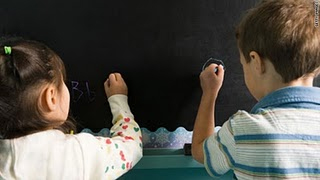| Parents of children with autism are understandably concerned about the likelihood that subsequent children will be affected. New research, made possible by Autism Speaks, shows that the chances are considerably higher than previous estimates. “These findings emphasize the importance of screening high-risk younger siblings,” explains Autism Speaks Chief Science Officer Geraldine Dawson, Ph.D., “because we know that early diagnosis and early intervention help children on the spectrum achieve their greatest potential.”  The study [1] is the largest ever of its kind and is being published online today by the respected journal Pediatrics [1]. It found that in families with one or more children on the autism spectrum, the chances that a baby sibling will develop autism are around 1 in 5, more than double previous estimates of 1 in 10 to 1 in 30. The rate was much higher among younger brothers (1 in 4) than among younger sisters (1 in 9). In families with more than one older child on the spectrum, 1 in 3 infants eventually developed autism. The severity of the older sibling’s autism did not affect the risk to younger brothers or sisters, nor did other family attributes such as parental age, ethnicity, or birth order. The study [1] is the largest ever of its kind and is being published online today by the respected journal Pediatrics [1]. It found that in families with one or more children on the autism spectrum, the chances that a baby sibling will develop autism are around 1 in 5, more than double previous estimates of 1 in 10 to 1 in 30. The rate was much higher among younger brothers (1 in 4) than among younger sisters (1 in 9). In families with more than one older child on the spectrum, 1 in 3 infants eventually developed autism. The severity of the older sibling’s autism did not affect the risk to younger brothers or sisters, nor did other family attributes such as parental age, ethnicity, or birth order.
In all, the researchers assessed 664 infants, all of whom had at least one older sibling with a verified diagnosis of an autism spectrum disorder (ASD). They enrolled infants very early (two-thirds of them before 6 months) before symptoms of autism become obvious. The clinicians then followed the babies through 36 months of age. They used gold standard diagnostic methods and comprehensive assessments performed by expert clinicians. (Visit Autism Speaks' website [2] to learn the early signs of autism, and Dr. Dawson’s accompanying commentary [3] for more information on how parents and healthcare providers can access important resources developed and supported by Autism Speaks.) “Previous studies were done in the 80’s and 90’s when different and more narrow diagnostic criteria were used,” Dr. Ozonoff says of the dramatic findings. “Previous studies also used different methods and some did not directly assess children.” “The implications of the study are clear,” Dr. Dawson adds. “Baby siblings of a child with ASD need to be tracked carefully. Pediatricians and other medical professionals should work actively with parents to monitor developmental milestones, especially those related to autism, and if needed begin intervention without delay.” Equally important, she adds, is the need to fund further research on how early intervention can be best used with infants and toddlers and whether it might be possible to develop preventive measures to help children not yet showing full symptoms. Autism Speaks made the study possible by organizing the High-Risk Baby Siblings Research Consortium, an international network that pools and coordinates studies of affected families in 21 sites in the US, Canada, Israel and the UK. Alycia Halladay, Ph.D., Autism Speaks director of research for environmental sciences, and Andy Shih, Ph.D., vice president of scientific affairs, organized the consortium in 2003, in partnership with the Eunice Kennedy Shriver National Institutes for Child Health and Development. Autism Speaks funded the participation of lead authors Sally Ozonoff, Ph.D., and Gregory Young Ph.D., both of the University of California-Davis MIND Institute and also funded the study’s analysis of collaborative results. The National Institutes of Health provided overall funding. Tags: Science, Alycia Halladay, early diagnosis, Geri Dawson, MIND Institute, Sally Ozonoff, Early Intervention, High Risk Baby Siblings |



